Dynamic evolution mechanism of cracks in eccentric decoupled charge blasting under high in-situ stress in rock mass
IF 4.4
2区 工程技术
Q1 ENGINEERING, MECHANICAL
引用次数: 0
Abstract
As a core technology for deep rock mass excavation, the blasting performance of the drilling-and-blasting method is profoundly governed by the coupling effect between charge configuration and in-situ stress fields. However, existing literature has not fully elucidated the mechanism of eccentric decoupled charge (EDC) induced by gravitational forces during field charging operations, nor its coupling dynamics with in-situ stresses. This study first establishes a theoretical model of the coupled stress field through mechanistic analysis to decode the stress superposition principle. Laboratory single-hole blasting experiments are then conducted to validate the numerical model and calibration parameters. Using numerical simulations, crack propagation patterns are systematically investigated under both stress-free and in-situ stress conditions. Hough transform-based image processing techniques are employed to quantitatively analyze the influence of the radial decoupling coefficient (M) on blasting crack distributions in stress-free environments. Fractal dimension theory and fractal damage mechanics are integrated to characterize crack propagation in isotropic/anisotropic stress fields and quantify stress-induced rock damage. Results indicate that the frequency of crack initiation on the coupled side exceeds that on the decoupled side by 5.67%–36.82%. In-situ stress exerts bidirectional control over crack evolution: the maximum principal stress dictates the direction of crack extension while reducing fractal damage by 9.3%–12.5%. Notably, EDC significantly alters dynamic stress evolution, with the peak disparity between tensile and compressive hoop stresses identified as the critical factor driving divergent crack patterns. The research findings clarify the coupling mechanism between EDC and in-situ stress. When applied to blasting engineering in deep surrounding rock, this mechanism can significantly improve the semi-perforation rate and reduce overbreak. The study provides a theoretical basis and technical support for smooth blasting in deep surrounding rock engineering.
岩体高地应力下偏心不耦合装药爆破裂缝动态演化机制
钻爆法作为深部岩体开挖的一项核心技术,其爆破性能在很大程度上受装药构型与地应力场耦合效应的影响。然而,现有文献尚未完全阐明电场充电过程中重力诱导偏心解耦电荷(EDC)的机理及其与地应力的耦合动力学。本研究首先通过力学分析建立了耦合应力场的理论模型,解码了应力叠加原理。然后进行室内单孔爆破试验,对数值模型和标定参数进行验证。通过数值模拟,系统地研究了无应力和地应力条件下的裂纹扩展模式。采用基于霍夫变换的图像处理技术定量分析了无应力环境下径向解耦系数(M)对爆破裂纹分布的影响。将分形维数理论与分形损伤力学相结合,表征各向同性/各向异性应力场中的裂纹扩展特征,量化岩石应力损伤。结果表明:耦合侧裂纹萌生频率比非耦合侧裂纹萌生频率高5.67% ~ 36.82%;地应力对裂纹演化具有双向控制作用,最大主应力决定裂纹扩展方向,使分形损伤降低9.3% ~ 12.5%。值得注意的是,EDC显著改变了动应力演化,拉压环向应力峰值差被认为是驱动裂纹模式发散的关键因素。研究结果阐明了EDC与地应力的耦合机理。将该机理应用于深部围岩爆破工程中,可显著提高半射孔率,减少超钻。研究结果为深部围岩工程光面爆破提供了理论依据和技术支持。
本文章由计算机程序翻译,如有差异,请以英文原文为准。
求助全文
约1分钟内获得全文
求助全文
来源期刊

Engineering Failure Analysis
工程技术-材料科学:表征与测试
CiteScore
7.70
自引率
20.00%
发文量
956
审稿时长
47 days
期刊介绍:
Engineering Failure Analysis publishes research papers describing the analysis of engineering failures and related studies.
Papers relating to the structure, properties and behaviour of engineering materials are encouraged, particularly those which also involve the detailed application of materials parameters to problems in engineering structures, components and design. In addition to the area of materials engineering, the interacting fields of mechanical, manufacturing, aeronautical, civil, chemical, corrosion and design engineering are considered relevant. Activity should be directed at analysing engineering failures and carrying out research to help reduce the incidences of failures and to extend the operating horizons of engineering materials.
Emphasis is placed on the mechanical properties of materials and their behaviour when influenced by structure, process and environment. Metallic, polymeric, ceramic and natural materials are all included and the application of these materials to real engineering situations should be emphasised. The use of a case-study based approach is also encouraged.
Engineering Failure Analysis provides essential reference material and critical feedback into the design process thereby contributing to the prevention of engineering failures in the future. All submissions will be subject to peer review from leading experts in the field.
 求助内容:
求助内容: 应助结果提醒方式:
应助结果提醒方式:


